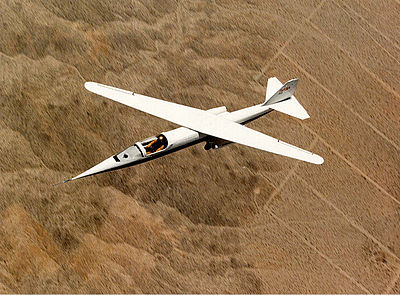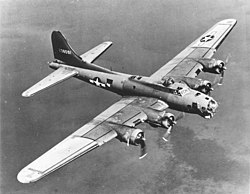Portal:Aviation
| Main page | Categories & Main topics |
|
Tasks and Projects |
The Aviation Portal

Aviation includes the activities surrounding mechanical flight and the aircraft industry. Aircraft includes fixed-wing and rotary-wing types, morphable wings, wing-less lifting bodies, as well as lighter-than-air craft such as hot air balloons and airships.
Aviation began in the 18th century with the development of the hot air balloon, an apparatus capable of atmospheric displacement through buoyancy. Some of the most significant advancements in aviation technology came with the controlled gliding flying of Otto Lilienthal in 1896; then a large step in significance came with the construction of the first powered airplane by the Wright brothers in the early 1900s. Since that time, aviation has been technologically revolutionized by the introduction of the jet which permitted a major form of transport throughout the world. (Full article...)
Selected article
Selected image

Did you know
...that Guy Menzies flew the first solo trans-Tasman flight (from Sydney to New Zealand) in 1931, but landed upside-down in a swamp? ...that Roy Marlin "Butch" Voris, founder of the United States Navy's Blue Angels flight demonstration team, chose the name based on a nightclub advertisement in The New Yorker magazine? ...that Washington Senators outfielder Elmer Gedeon, who pulled a crew member from a burning wreck, died while piloting a B-26 bomber over France?
General images -
In the news
- May 29: Austrian Airlines cancels Moscow-bound flight after Russia refuses a reroute outside Belarusian airspace
- August 8: Passenger flight crashes upon landing at Calicut airport in India
- June 4: Power firm helicopter strikes cables, crashes near Fairfield, California
- January 29: Former basketball player Kobe Bryant dies in helicopter crash, aged 41
- January 13: Iran admits downing Ukrainian jet, cites 'human error'
- January 10: Fire erupts in parking structure at Sola Airport, Norway
- October 27: US announces restrictions on flying to Cuba
- October 3: World War II era plane crashes in Connecticut, US, killing at least seven
- September 10: Nevada prop plane crash near Las Vegas leaves two dead, three injured
- August 6: French inventor Franky Zapata successfully crosses English Channel on jet-powered hoverboard
Related portals
Associated Wikimedia
The following Wikimedia Foundation sister projects provide more on this subject:
-
Commons
Free media repository -
Wikibooks
Free textbooks and manuals -
Wikidata
Free knowledge base -
Wikinews
Free-content news -
Wikiquote
Collection of quotations -
Wikisource
Free-content library -
Wikiversity
Free learning tools -
Wikivoyage
Free travel guide -
Wiktionary
Dictionary and thesaurus
Selected biography
Elizabeth Muriel Gregory "Elsie" MacGill (27 March 1905 – 4 November 1980), known as the Queen of the Hurricanes, was the world's first female aircraft designer. She worked as an aeronautical engineer during the Second World War and did much to make Canada a powerhouse of airplane construction during her years at Canada Car and Foundry (CC&F) in Fort William, Ontario. After her work at CC&F she ran a successful consulting business. Between 1967–1970 she was a commissioner on the Royal Commission on the Status of Women in Canada, published in 1970.
Selected Aircraft

The Boeing B-17 Flying Fortress is an American four-engine heavy bomber aircraft developed for the U.S. Army Air Corps (USAAC). Competing against Douglas and Martin for a contract to build 200 planes, the airplane outperformed both the other entries and the Air Corps' expectations. Although losing the contract due to an accident, the Air Corps was so in favor of the B-17 that they ordered 13 B-17s regardless. Evolving through numerous design stages, from B-17A to G, the Flying Fortress is considered the first truly mass-produced large aircraft. From its pre-war inception, the USAAC touted the aircraft as a strategic weapon; it was a high-flying, long-ranging potent bomber capable of defending itself. With the ability to return home despite extensive battle damage, its durability, especially in belly-landings and ditchings, quickly took on mythical proportions.
The B-17 was primarily involved in the daylight precision strategic bombing campaign of World War II against German industrial targets. The United States Eighth Air Force based in England and the Fifteenth Air Force based in Italy complemented the RAF Bomber Command's night-time area bombing in Operation Pointblank, which helped secure air superiority over the cities, factories and battlefields of Western Europe in preparation for Operation Overlord. The B-17 also participated, to a lesser extent, in the War in the Pacific.
Today in Aviation
- 2012 – The People's Republic of China commissions its first aircraft carrier, Liaoning, at Dalian Port, China.[1]
- 2011 – Buddha Air Flight 103, a Beechcraft 1900D, crashes while attempting to land in dense fog at Kathmandu Tribhuwan International Airport, killing all 16 passengers and 3 crew members.
- 1998 – PauknAir Flight 4101, a BAe 146, leaves Málaga but never reaches its destination in Melilla. All passengers and crew perish.
- 1997 – Launch: Space Shuttle Atlantis STS-86 at 10:34:19 pm EDT. Mission highlights: Shuttle-Mir docking.
- 1991 – First flight of the British Aerospace Jetstream 41
- 1978 – PSA Flight 182, a Boeing 727, collides with a Cessna 172 over San Diego, California, United States; all 135 aboard the airliner, both pilots of the Cessna, and 7 people on the ground are killed, making this the worst aviation disaster in California history.
- 1975 – A flight of four Lockheed F-104G Starfighters of the Aeronautica Militare Italiana (Italian Air Force) crash in formation into a field near the village of Ralingen near the border with Luxembourg, ~12 miles S of Bitburg, West Germany, shortly after take-off from Bitburg Air Base, killing all four pilots. The four jets flown by an Italian Air Force lieutenant colonel and three captains came down just five minutes after departing. The Bitburg control tower operated by the United States Air Force in Europe said that radio contact with the flight was lost almost immediately after they took off into overcast skies. "They crashed in line, the four craters being within an area of one square kilometer (about four-tenths of a square mile)," a German defense ministry spokesman said. The last crash of a formation of Starfighters occurred in West Germany in 1962 when an American pilot teaching stunt flying to three Germans led his formation in a dive into an abandoned strip mine near Cologne.
- 1964 – The No. 412 (T) Squadron became the first Regular Force squadron in the Royal Canadian Air Force to complete twenty-five years of service and to receive its squadron standard.
- 1960 – A U. S. Navy F4H-1F Phantom II sets a world speed record over a 100-km (62.1-mi) closed-circuit course, averaging 1,390.24 mph (2,237.27 km/hr). FAI Record File Number 8898.
- 1959 – A United States Navy Martin P5M-2 Marlin, BuNo 135540, SG tailcode, '6', of VP-50, out of NAS Whidbey Island, Washington on Puget Sound, is forced to ditch in the Pacific Ocean, about 100 miles (160 km) W of the Washington-Oregon border after fire in the port engine, loss of electrical power. A Betty depth bomb casing is lost and never recovered, but it was not fitted with a nuclear core. Coast Guard cutter USCGC Yocona, out of Astoria, Oregon, rescues all ten crew after ten hours in a raft. A Coast Guard Grumman UF Albatross amphibian directed the vessel to the crew. The press was not notified at the time.
- 1958 – Boeing RB-47E-25-BW Stratojet, 52-276, c/n 450947, is written off when it veers off runway, landing gear collapses, port inner engine nacelle torn from mount, suffers fire. Post crash footage: http://www.criticalpast.com/video/65675022547_Boeing-B-47-Stratojet-bomber_crash-during-take-off_officers-examining_runway
- 1958 – Supermarine Scimitar F.1, XD240, 'V-145', of 803 Naval Air Squadron, arriving aboard from RNAS Lossiemouth via RNAS Yeovilton, falls off the side of HMS Victorious at low speed into the English Channel off Portsmouth after failure of the No.1 arrestor wire upon landing. The pilot, Cdr. John Desmond Russell, the Squadron CO, is unable to open the canopy, and trapped in the cockpit, he drowns when the airframe sinks to the seabed, despite efforts of plane guard crewmen Lt. R. A. Duxbury from the rescue Westland Whirlwind. Members of the press had been invited along to watch 803 Squadron embark. Nose of aircraft and pilot's body recovered four weeks later.
- 1955 – The Royal Jordanian Air Force is founded.
- 1953 – The last Boeing B-29 Superfortress to be delivered, Boeing-Wichita-built B-29-100-BW, 45-21872, in September 1945, converted to a WB-29, was destroyed in a crash this date near Eielson AFB, Alaska, while assigned to the 58th Strategic Reconnaissance Squadron (Medium), Weather.
- 1945 – First flight of the de Havilland Dove
- 1943 – (25-26) Allied aircraft attack airfields on Corsica and ferry traffic between Corsica and Italy, and shoot down four German transport aircraft.
- 1942 – S/L KA Boomer, CO of No. 111 Squadron, destroyed a Japanese Nakajima A6 M2-N (Ruff) fighter over Kiska, Alaska. This was the only RCAF air combat in the North American theatre of war.
- 1940 – The bombers of the Corpo Aereo Italiano (Italian Air Corps) arrive at their base in Belgium to participate in the Battle of Britain. The fighters will arrive later.
- 1939 – Nicola di Mauro of Italy sets a world seaplane altitude record of 13,542 m (44,429 feet) in a Caproni Ca.161Idro. This record still stands for piston-engined seaplanes.
- 1939 – Blackburn B-24 Skua crewed by Lt. Bruce Straton McEwan, RN, and Petty Officer B. M. Seymour of No. 803 Squadron, launched from HMS Ark Royal, becomes the first British fighter to down a German aircraft in World War II when they attack a Dornier Do 18 flying boat over the North Sea.
- 1932 – Lewis Yancey sets an autogiro (right) altitude record of 21,500 ft (6,553 m) in a Pitcairn PCA-2
- 1918 – Chief Machinist's Mate Francis E. Ormsbee went to the rescue of two men in a plane which had crashed in Pensacola Bay, Florida. He pulled out the gunner and held him above water until help arrived, then made repeated dives into the wreckage in an unsuccessful attempt to rescue the pilot. For his heroism, Chief Ormsbee was awarded the Medal of Honor.
- 1912 – Charles Voisin dies and Raymonde de Laroche suffers serious injuries in an automobile accident near Lyons, France.
- 1909 – French Army airship La République crashes over Avrilly, Allier, killing its crew of four. It was caused by a broken propeller which sheared through the envelop causing rapid leakage. This crash marks the first military airship fatalities.
- 1903 – The Wright brothers arrive at Kitty Hawk, North Carolina to begin tests of their first powered aircraft.
References
- ^ "Anonymous, "China Navy's First Aircraft Carrier Commissioned After Sea Tests,"". Bloomberg News (Bloomberg.com). September 25, 2012. Retrieved December 2, 2012.
- Shortcuts to this page: Portal:Airplanes • P:AVIA




















































